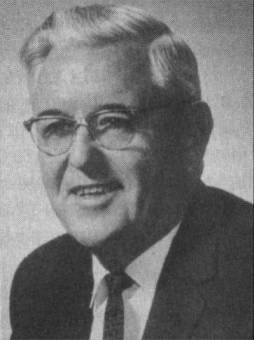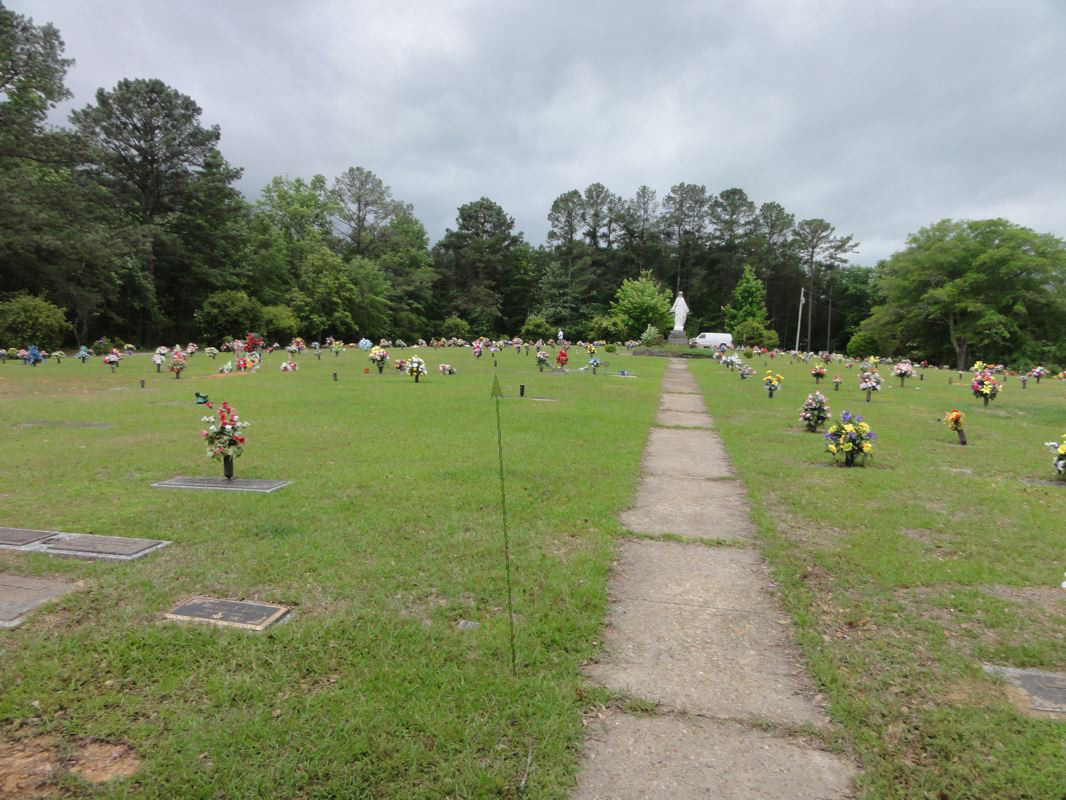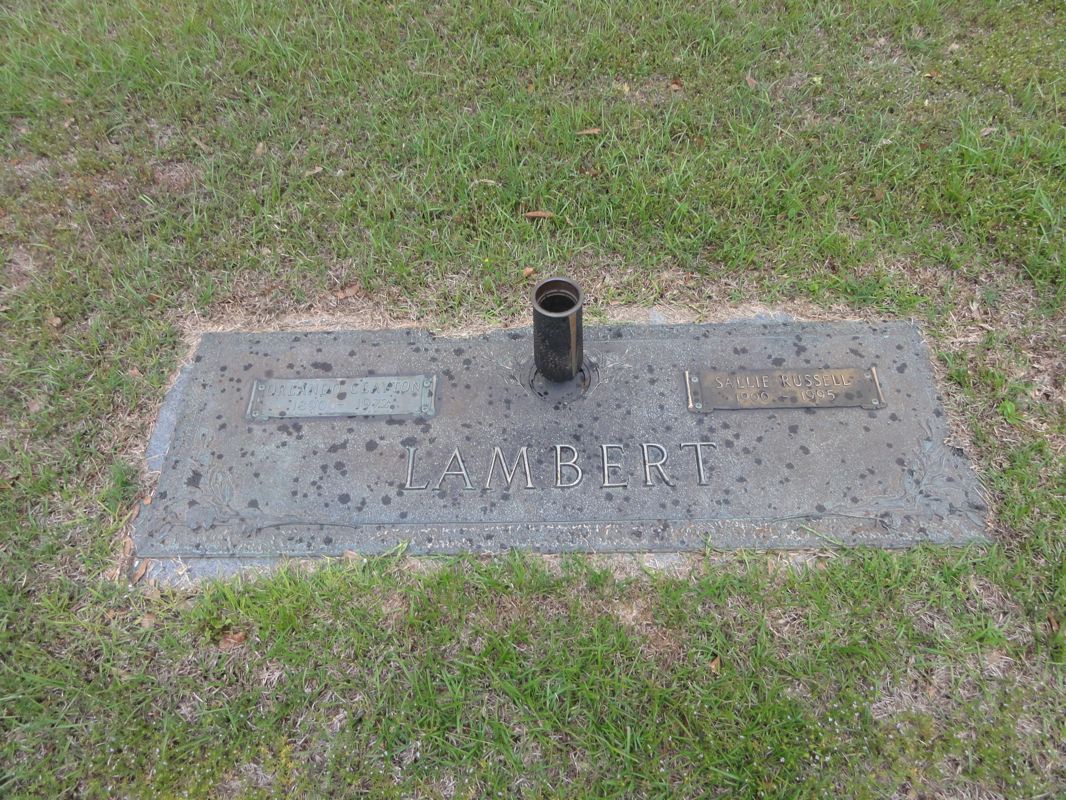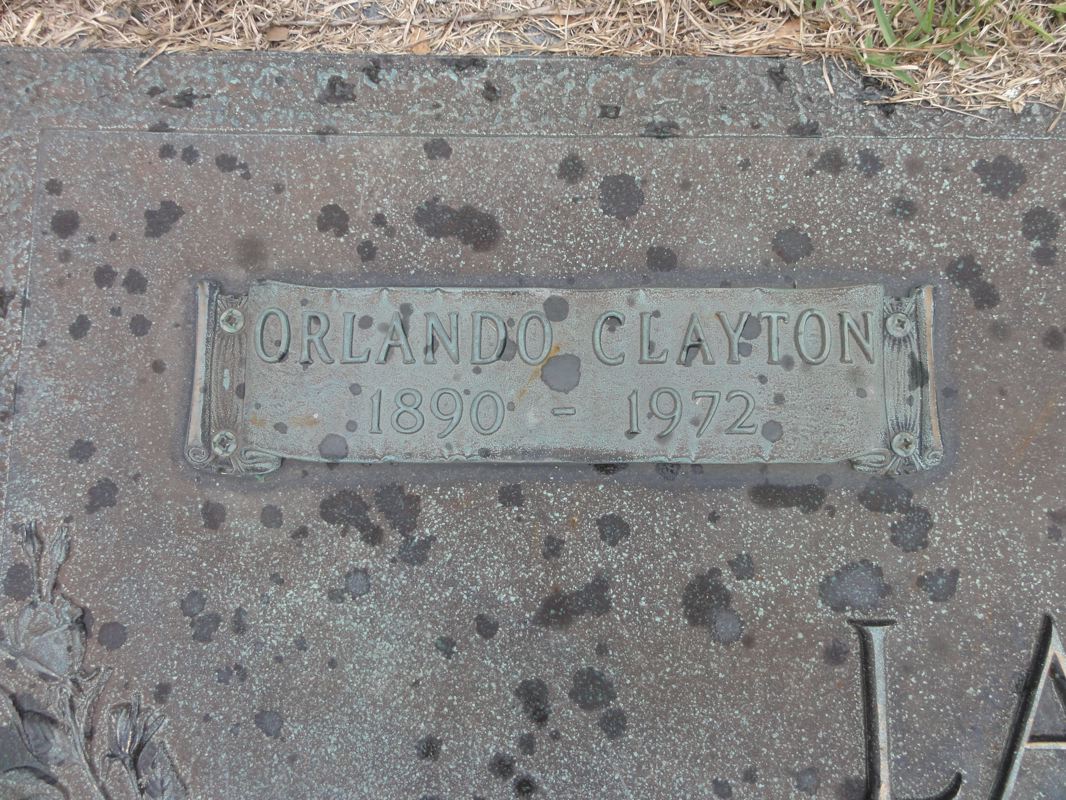Orlando Clayton Lambert
1890-1972

Biographical Sketch On The Life Of O.C. Lambert
Orlando Clayton Lambert was born September 16, 1890, of very poor parents in the poor hills of Alabama, only 25 years after the devastating Civil War. In fact, his mother was born three weeks before the assassination of President Lincoln.
There were no schools worthy of the name, and no market for any surplus from the farm, so as a lad he could see little prospect for escape from severe poverty. For some reason, at a very early age, he acquired a passionate love for books.
When he was 17 years old he secured a teacher's certificate, though at the time he had never attended a grade school, or sat at a desk. Since his earliest memory he had wanted to preach, but teaching was the only thing that he could see to do. He knew no one more experienced to advise him, and no one years teach with means to whom he could appeal. He spent 12 years teaching at a starvation salary.
About the only book the family had at first was a large family Bible, and he learned to love it. When he became a ploughboy he would paste a page from a cheap New Testament on the plow handle and he memorized a great portion of the New Testament while he worked. He began to lead singing for gospel meetings while yet a teen-age boy trying to learn from the older preachers before he gained confidence enough to try his own wings. It never entered his mind that a man could spend all his time preaching the gospel and live, for the preachers that he knew best were farmers whose family made the living while he baptized hundreds and planted churches.
For several years after he began preaching he would teach the short term of school in the winter, "make a crop" in the Spring, preaching on Sundays, and holding meetings in the Summer. No one thought enough of his preaching to send him out to preach, or to send for him, so he went! He preached in school houses, residences, under brush arbors, and under the trees, where the church had never been planted. Many times he would go into a sectarian neighborhood, work up a singing school, stay in the homes where people were not members of the church, but his main purpose was to hold a meeting at night. After half a century he looked back with great pleasure to see that in almost every place where he helped plant the church, others had watered, and the result was good churches over a wide area. Those years were fruitful in the converts made, but most of all for the spiritual growth it afforded him. But there was no money in it, he frequently had difficulty paying his fare back home, to begin teaching again. Financially he was in a poor circle.
His struggles continued unabated as he finally attended college. First at Highland Home College (long ago discontinued), then Nashville Bible School and Peabody.
In those early years, when a beardless boy began to preach in a sectarian neighborhood he was invariably challenged by older and more experienced denominational preachers. He looked back with pride to some of those debates. Knowing that these doctrines would have to be met, he bought all the denominational books that he could find regardless of the sacrifice he had to make to buy them. This helped in defending the truth.
Before he had preached many years he moved into a section where 65 percent of the people were Catholics. He had for years been accumulating their books. He wanted to know of a certainty what they taught and what they had done and were doing. He remained in this area for 16 years, and most of his converts were from the Catholic Church. The church was very weak in that area, but now it is thriving. Many of the elders and preachers were among his converts. Volumes of interesting stories could be written concerning those converts.
Life had been so hard that he dreaded the prospects of poverty in old age, so he established a printing business. Though he had opposed the Catholic Church vigorously, one of his pleasant surprises was that some of his best customers Were Catholics. He established this business for several reasons. First, he wanted to be able to print this material which he had gathered through so many years, which brethren in whom he had great confidence insisted that by all means it should be printed. He wanted to keep his three boys near him, and to have some means of living with dignity and honor in old age.
His health, which had never been robust, was steadily declining. In 1941 a series of misfortunes overtook him and quickly wrecked and brought to nought his carefully nurtured plans. First, his business burned, then a few months later his faithful wife, who was apparently in excellent health, died suddenly, leaving him with a 13 year old son. Soon thereafter he suffered a series of nine serious operations which kept him in and out of the hospital for four years. All of his life's savings were gone and he could see no reason to even hope to be well again.
One year after the death of his wife, he married again, which proved to be one of his life's greatest blessings. He married Sallie Russell. She nursed him back to health, bouyed him up when he was discouraged, and in every way proved to be "a help meet" for him. Looking back on his 56th year, so dark, it seemed almost miraculous that nearly 20 years later his health had continued to improve year after year and he was enjoying more vigorous good health than almost anyone his age.
By the time he reached his 60th year his health had so improved that he began to believe that his long interrupted dream of putting his material into print could be realized. So, beginning at the age of 62, he spent two years, working early and late, putting the manuscript for "Catholicism Against Itself, Volume 1 " into shape. When he was 64 he had gathered more than 1,600 names and addresses of brethren, mostly preachers, who said they wanted his book. After he had it printed and had a printing bill for about $6,000, he sent out notices, and to his consternation more than 1,200 of them never replied. Twelve hundred preachers had moved.
He was now 64 years old! He could think of no possible way of paying this debt, except to travel among the churches, lecturing on this important theme and selling his book. For eight years he traveled almost constantly, visiting 40 States and most of the provinces of Canada. He lectured in more than a thousand churches.
To add to his financial difficulties when he launched out on his lecture tours, he moved out of a church owned home, and had to provide some place to live. He borrowed a thousand dollars to make a down payment on an old home that no one else would have. "During the years of my travels my wife superintended the remodeling of our old house and built a library for my books, and a workshop, while she taught school to keep the wolf away from the door, " he recalled.
There was a great deal of important matter that could not be crowded into Volume 1 of his book, so, stopping his travels ' he decided that if he ever wrote and printed Volume 2, he would have to get busy at it. When he checked up on his finances he was $7,000 in the red. He had worried no little about what would become of his library after his passing. Knowing the Catholic doctrine of Mental Reservation, he knew they would deny every quotation he gave unless the books were available. This was the reason that when every resource was exhausted due to his misfortunes, he kept the books, even though he had offers to buy them. Several colleges asked for them. When Abilene Christian College learned of his financial difficulties they offered to pay off his indebtedness in order to secure his library.
This relieved his immediate need, but during the three years he spent doing the fabulous amount of research in writing Volume 2, he had nothing besides a Social Security check to live on. There were three churches that gave him what altogether amounted to $40 per month. It was difficult to live on this amount, but, without it Volume 2 could not have been written.
Volume 1 and Volume 2 of "Catholicism Against Itself" have long since been printed and reprinted and widely circulated through the nation. In addition to these two volumes, Lambert authored three other books: "Rumbling From Rome," "Russellism Unveiled," and "Catholicism Against Itself-Abridged."
O.C. Lambert died March 5, 1972, at Winfield, Alabama. He was survived by his wife, Sallie; three sons, Horace M. Lambert, O.C. Lambert, Jr., and Hillman Lambert. Funeral service was held at the Church of Christ in Winfield, Alabama, with John Stephens, E. Claude Gardner and Basil Doran officiating. Burial was in Gu-Win, Alabama, with interment in Memorial Garden Cemetery.
-In Memoriam, Gussie Lambert, Shreveport, LA, c.1988, pp.167-170
![]()
A Christian Lady Honored
On the evening of March 3, 1973, Christians at Winfield, Alabama joined with International Bible College, to honor Sallie Russell (Mrs. O.C.) Lambert. A large audience listened attentively as Basil Overton, Editor of the World Evangelist, Sterling Pate, elder at Winfield and Charles Coil, President of International Bible College paid tribute to Sister Lambert. R. L. Garner, business man and gospel preacher at Winfield presented the college with a large portrait of Sister Lambert. The portrait now hangs in the entrance hall of IBC. The college presented a plaque to Sister Lambert and a copy of the plaque will be placed beneath her portrait at the college.
The plaque reads as follows: Sallie Russell Lambert, whose lovely spirit and dedicated service has demonstrated for one half century the beauty of Matthew 6:33 and Matthew 7:12. Presented March 3, 1973 by Saints of Winfield, Alabama Church of Christ and International Bible College.
A memorial fund was also begun that night (March 3) in memory of O.C. Lambert, a great gospel preacher who went home to be with the Lord March 5, 1972. The fund will be used to buy books for the library at IBC. The article that follows is a summation of the love, labor and faith of this great lady in the church.
The story of Sallie Russell (Mrs. O.C.) Lambert (Written by Charles Coil and Saundra Garner who interviewed sister Lambert recently at her home in Winfield, Alabama.)
The story of Sallie Russell Lambert parallels the growth of the church in the first half of the twentieth century and exemplifies the beautiful qualities of character that have caused the church to grow across the whole panorama of Christian history. It is a record of preachers who lived and labored on $30.00 per month and Sallie Russell, a lovely young school teacher who refused to eat lunch in order that she might give an extra $2.00 per month to the evangelist and his family. The story covers that period of time when churches on the Gulf coast rented quarters above dance halls, old carriage houses and other out of the way places. Many saints, both old and young, found the problems too great for their faith. Some went with the denominations and others merely quit. Sallie Russell helped supply the labor, the prayers, the tears, the personal teaching and the money to bring. about growth.
Sister Lambert was born September 27, 1900 near Winfield, Alabama. She was baptized by Gus Dunn in her thirteenth year. Early schooling was received by her in the local schools of Fayette and Marion Counties. She was graduated from high school at Marion County High of Guin, Alabama. Sister Lambert attended college in Florence, Alabama at State Normal College where she was graduated in 1925. This was accomplished by teaching school terms in the winter and attending college when local schools were not in session.
During the period from 1921 to 1929 Sister Lambert often worshipped and taught a Sunday School class at old Poplar Street Church. After graduation at Florence she taught one year (1925) in Jasper, Alabama. A young man named Gus Nichols was beginning to preach in that area. The church met in the Walker County court house and Sister Lambert still remembers the strong unpleasant smell of the spittoons.
The years from 1925 to 1929 were spent, for the most part, in Florence. The summer of 1927 found her in school again at Auburn, Alabama. Sister Lambert described the situation as follows.
All during my teaching career, I would take extension courses and summer classes at different colleges. In the summer of 1927, I went to Auburn. When I got there I found no church of Christ, only a small Christian Church. Through the school office, I found two other members. I also talked with two of the professors who went to the Christian Church. The first Sunday we were there we went to the Christian Church, explained our situation, and asked if they would leave off the music that summer in order that we might worship with them. Much to our surprise they did and as was my custom I taught a class. I had been places where the congregation had no meeting I house but Auburn was my first experience where there was no one to meet with and no place to meet. (From A Sketch of My Life, Sallie Russel Lambert, Original and Unpublished Mss., p. 3, Heritage Christian University Library)
From 1925 to 1929 Sister Lambert taught a class for exceptional children at old Brandon School in Florence. In the fall of 1929 a special school for problem boys was opened in Mobile, Alabama. The young Sallie Russell was invited to join the faculty as the only woman teacher. When she arrived in Mobile the church was not to be found. She put ads in the newspaper, inquired at the Chamber of Commerce and asked all her friends but no one knew of the Church of Christ. Finally she wrote to a gospel journal to see if any papers were mailed to Mobile. An address was returned to her of the only Mobile subscriber and in this way she came in contact with the church.
Her first Sunday with the group is still well remembered. The location was a little room on State Street, a slum area of town. Sister Lambert remembers that there were thirteen chairs and five people present. A Sister Holt and the Robert Ruble family made up most of the membership. A bit later Brother Ruble found a dance floor that could be rented.
Sister Lambert was soon active in beginning a ladies class that would meet for the next fifteen years and would finally average fifty women in attendance. At this time, however, she "rounded up" nine girls to begin the class. Class members were secretaries and sales girls she knew in Mobile. None were members of the church. Soon all nine were baptized! Indicative of her impact on the church is the fact that the average attendance for the school year of 1931-32 was fifteen for the whole church and nine of these were ladies recruited by Sister Lambert!
In 1931 Sister Lambert wrote N.B. Hardeman for advice on establishing the church on a permanent basis. Brother Hardeman came to help. As an outgrowth of his visit Brother A.H. Maner was secured to work on a full time basis and the church bought an old carriage house on Church Street. Remodeling work was done by members who donated their time and the first Sunday they had thirty-five people present in their new meeting place.
The next twelve years saw Sallie Russel settle into routine that was greatly productive in saving souls. She taught school for a livelihood and devoted evenings, weekends, and summers to the Lord's work. She visited, recruited, cleaned the building, taught classes and did "cottage meeting work." During this period she taught Catholics, Baptists, Presbyterians, and members of the Christian Church. The church in Mobile grew strong and several other congregations began.
In 1943 she married O.C. Lambert, whom she had known since childhood. It was a union of two hearts completely dedicated to Christ. Very few couples could be found so alike as these two. Both came from Winfield, Alabama. Both obeyed the gospel young in life and began at once to work for God. Neither ever looked back. Both struggled for their education, both taught school, both were superlative workers and either would have died for the faith. The chief difference in their background was a ten year age differential. Brother Lambert's first companion had been called away by death and he was left with young sons. Sallie Russell began a new career as wife and mother on March 21, 1943.
From 1943 until the passing of Brother Lambert in 1972 these two Christians walked the road together. Of this period in their lives Sister Lambert has written:
In 1929 Lambert's youngest son was born. I claim him as my own, for after his mother's death he courted me almost as hard as his father did, taking part in all our plans. So when we were married, our work was the same as one. The two of us could and did make more converts, some of them at great sacrifice to all concerned. (A Sketch of My Life, Sallie Russell Lambert, Unpublished Mss., p. 7, (Heritage Christian University Library)
Again she wrote:
Lambert converted more Catholics than any man of his time. He held more debates than any man I have known. Like me, he never refused to go and preach (or teach) when an opportunity presented itself. (Op. cit., p. 7.)
There is so much to be told that would bless younger Christians but how can we put it in a short (or long) article? We can marvel at the books Brother Lambert wrote and rejoice at the debates conducted and the churches established. We can look at the pictures and see two people who appear to be good looking, intelligent and possessed of grace and charm. In so doing we will not see a fraction of the true picture. No one but a preacher's wife can understand the stress of making a home for a man who is generally underpaid but is constantly involved in preaching, personal evangelism, debating, writing and publishing. We will not see the heroic, tight-lipped battle that O.C. Lambert fought for thirty years with spirit breaking, disabling, grinding pain. We will miss the twenty-five years of school teaching that Sister Lambert carried on the help finance their many good works and we will not hear of the days and nights when she nursed him through five major operations.
The following paragraph, written a few weeks ago by Sister Lambert is very revealing of the character of this lady. In it she tells how she began her service to God, the things that were most important over the years and in unequivocal language declares her present outlook. With this we close. As important and rewarding as my teaching was to me, it was nothing compared to the church and its work. I obeyed the gospel when I was thirteen. I wanted to when I was twelve, but my father was a Methodist and rather prejudiced and since I loved him dearly, I put it off. The following summer, I was baptized by Brother G. A. Dunn, Sr. The baptizing was done in Luxapalia Creek just below the mill dam.
That was the first time I ever remember seeing my father cry. By the time I was baptized, I had read the Bible through five times, skipping all the big words of course, but I knew and felt the duties and responsibilities of being a Christian. I began teaching a Sunday School class at a very early age and continued to do so until I had to give it up to care for my invalid husband who passed away March 5, 1972. (Op. cit., p. 2.)
-The World Evangelist, May, 1973, pgs. 6,7
![]()
O.C. Lambert
It was my pleasure to know O. C. Lambert. He came to the mission field where I labored, and presented a series of lessons. He was a humble, able, and faithful gospel preacher. He went to be with the Lord March 5, 1972.
Brother Lambert was truly a defender of the faith. (Jude 3.) He loved the truth, and he loved people. He had what he called Twelve Rules For Life. These rules are based on the Bible, and are very practical. They are:
1. Begin each day with prayer.
2. Work hard.
3. Love your family.
4. Make light of your troubles.
5. Follow the Golden Rule.
6. Read the Bible every day.
7. Show kindness.
8. Read good books.
9. Be clean and pure.
10. Have charity in your heart
11. Be obedient and respectful.
12. End the day in prayer.
Few men suffered more physical discomfort than O.C. Lambert. Yet, he was patient in suffering. He longed for the rest that God promised his faithful people.
- , Editor, World Evangelist, May, 1973, p.7
![]()
Directions To The Grave Of O.C. Lambert
O.C. Lambert is buried in Marion County Memorial Gardens in Gu-Win, Alabama. From Birmingham, Alabama head toward Memphis, Tennessee on Hwy. 78/I-22 Corridor. Take the Winfield exit, Hwy. 129. Go south and hit Hwy. 118. Turn right (west). Go through Winfield, heading toward Guin. Just west of the city of Winfield is the small unincorporated town of Gu-Win. (Note: It is before the city of Guin.) As you enter Gu-Win look to your left and enter the Memorial Garden Cemetery. Park in front of the section just behind the sign. Head toward the statue in the middle of the section. Count 10 rows on the left. You will pass the Lambert site just two grave in from the left of the sidewalk. Just before the grave of O.C. Lambert and near to the walk is the grave of another gospel preacher, J.O. Jones.
GPS Location
33.948126,-87.860807
View Larger Map
![]()
![]()



